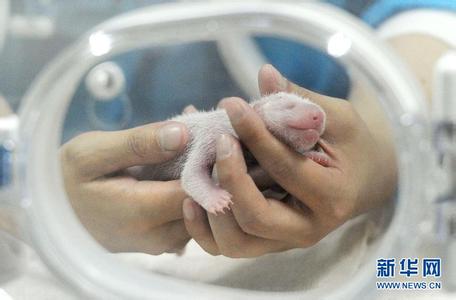When you go to the zoo, the sight of Giant pandas munching away on bamboo and trying to climb up and down hills -- will definitely melt your heart. But do you know what it takes to care for the newborn cubs?
Giant pandas are big and strong.
But newborn panda cubs are incredibly tiny and fragile.
Pandas are born premature -- pink, blind and toothless, and usually weighing around 120 grams. Just about 0.1 percent of an adult panda's body weight.
It takes just 25 days for the giant panda’s distinctive looks to start to appear.
To ensure the cub’s survival, both its mother and their keepers are extremely careful.

When you go to the zoo, the sight of Giant pandas munching away on bamboo and trying to climb up and down hills -- will definitely melt your heart. But do you know what it takes to care for the newborn cubs?
The keepers have to monitor both mother and cub day in and day out to ensure they are in good condition.
"We see that a rising number of giant pandas need conservation efforts to survive. And we are under tremendous pressure to take good care of these young ones. Every day, we observe the cub’s mental condition, its feces, and breathing. We take note all of their comprehensive data to see if they are healthy – for example, we monitor the amount of milk the newborns need to stay strong. It is a lot of work," said Chen Min, panda cub keeper, Giant Panda Research Base, Sichuan.
The giant panda is an endangered species, due to their notoriously low reproduction rate. And it’s important that their natural habitat remains safe. According to statistics, the giant panda’s natural habitat in the provinces of Sichuan, Gansu and Shaanxi have actually expanded. However, protecting their habitat and their living eco system still requires continued, long-term efforts.
"On one hand, the current giant panda’s population has grown steadily. But on the other hand, we see that the entire eco system and habitat for the giant panda and related animals are still being threatened," researcher Qi Dunwu said.
In 1995, there were only about 1,000 wild giant pandas. Now there are nearly 2,000 living in the wild, with nearly 400 in captivity around the globe.
However, a statement from the IUCN cautioned that its reassessment of the giant panda was not yet complete. In any case, it is clear that although numbers are rising, the fate of the giant pandas lies squarely in the hands of conservation efforts. And fans of the animal think that those efforts are of utmost importance.
Giant pandas are one of the world’s rarest living mammals. And for China, the cuddly bear has also been considered as the panda diplomacy showing the country’s prosperous relationship with others. It is also the world’s responsibility to save this vulnerable species. Liu Yang CCTV Sichuan Province.















